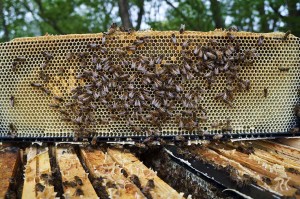You remember the previous post about the “multiple test”(MT)-colony, natural positioning, plastic frames, a mouse (or mice), mild winter and what a good condition this colony came out with now in spring. I’ve been thinking about it.
Mild winter
Yes the mild winter has contributed to the good condition. But what about varroa and viruses? Mild winter doesn’t help if you have too much of both in a colony. I would say maybe the contrary, or at least questionable. A lot of varroa triggers extensive brooding, to kind of replace the affected sick brood resulting in a bad rat race.
But less treatment
In fact one of the colonies in the apiary died during winter due to what looked like virus problems, in spite of some more treatment than the good colony got. And another colony which hadn’t received any treatment last year because it didn’t need it, it seemed, no DWV-bees, strong and healthy look – came out with fist size cluster and asking for survival until fresh pollen and steady temp around 60F (15C). We’ll see.
And this good colony got less Varroa treatment 2013 compared to 2012, actually half – at the most only a tenth compared to non-selected bees for Varroa resistance. With the same queen 2012 and 2013.
Weaker varroa pressure
Now I think in spite of the dead colony and the one with the fistsize cluster, the average Varroa pressure, total amount of mites in the apiary, was less in 2013 compared to 2012. In fact I think this is the case in all my apiaries. Because I used in average about half the amount of thymol I used in 2012. This good colony I’m talking about specifically now got the average amount, 5 grams. Also, only 50% of the colonies going into winter had been treated during 2013, compared to 80% 2012. And, this spring winter die off will be less than 5% compared to more than 15% last spring.
The Varroa pressure I think is lower due to better Varroa resistance in average in my stock, also in this apiary. The least good ones are showing up every spring, either they die in spite of treatment, or they show up weak and get treatment and later their queens are shifted.
Epigenetics and social learning
Also, from other beekeepers experiences, after about 5 years, mite pressure becomes weaker without any obvious reason. Probably some kind of epigenetic adaption (genes turned on and others turned off) is taking place that takes about 5 years from the first time the mites created problems. This spring is the fifth since the mites gave big problems the first time in all my apiaries.
This adaption to the presence of the mite and fighting it probably also involves social learning. Bees learning to handle the mite and pass this knowledge on to other bees in the hive (http://www.hindawi.com/journals/psyche/2013/768108/). Therefore it’s important not only to propagate good resistant bee colonies by making new queens from it, but also by making new bee colonies from it, including worker bees that can pass their knowledge to new generations of bees.
Uniform small cells
From the dead colonies through these diffcult years with Varroa I have harvested quite some badly drawn small cellsize combs. With too many patches of drone comb, and too many patches of bigger sometimes irregular “worker” cells. Good they have been culled.
These plastic frames with plastic foundation with cellsize about 4.95 from Mann Lake (http://www.elgon.es/diary/?p=119) that was used in the bigger part of the third (the uppermost) broodbox in the MT-colony at least didn’t have a big negative impact on the colony health. Plastic haters might draw such a conclusion right away. Now, I’m not a plastic lover. I don’t like using plastic. That’s because in general it isn’t degradable in nature. That’s what I want, degradable plastic. But here it is in our world and I tried it.
These plastic frames might even have contributed to the good health of the MT-colony. 10% more cells per comb, still quicker build up. No drone patches (BUT there should be drone patches here and there in the brood area to catch the mites that are there), no patches of bigger and irregular “worker” cells. No wavy combs (I use no wiring in my wax combs). No big bridges of hindrance of wood for the queen between brood boxes.
So I plan to try some more plastic frames from Mann Lake in brood boxes. But there should be a good balance between plastic and wooden frames as long as I will be using the plastic.
